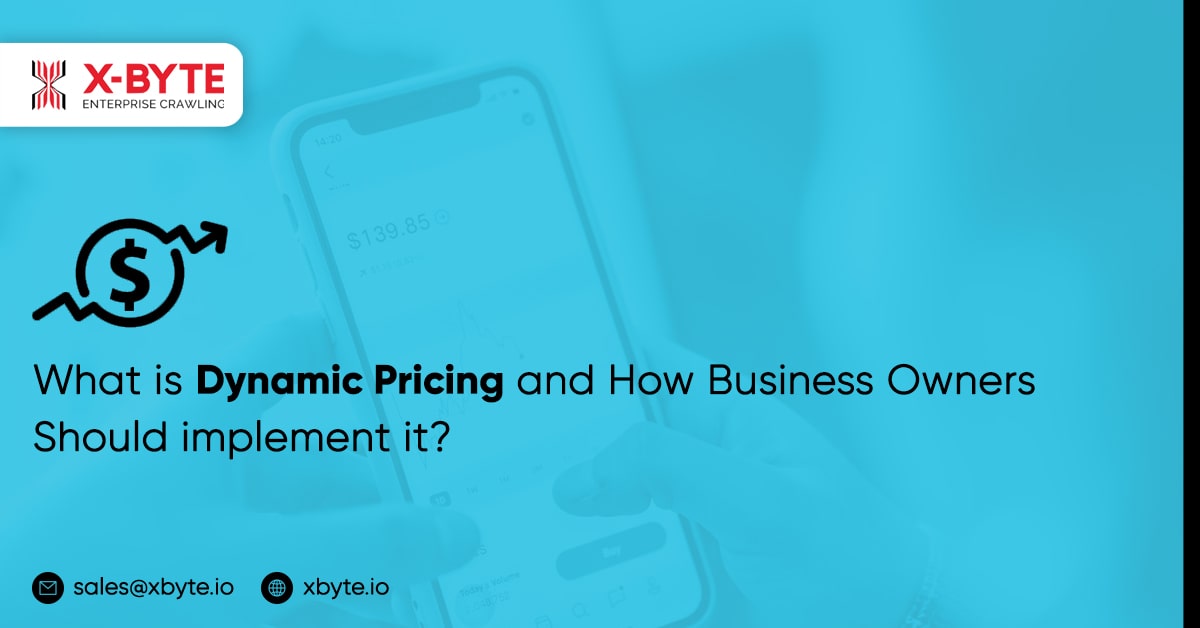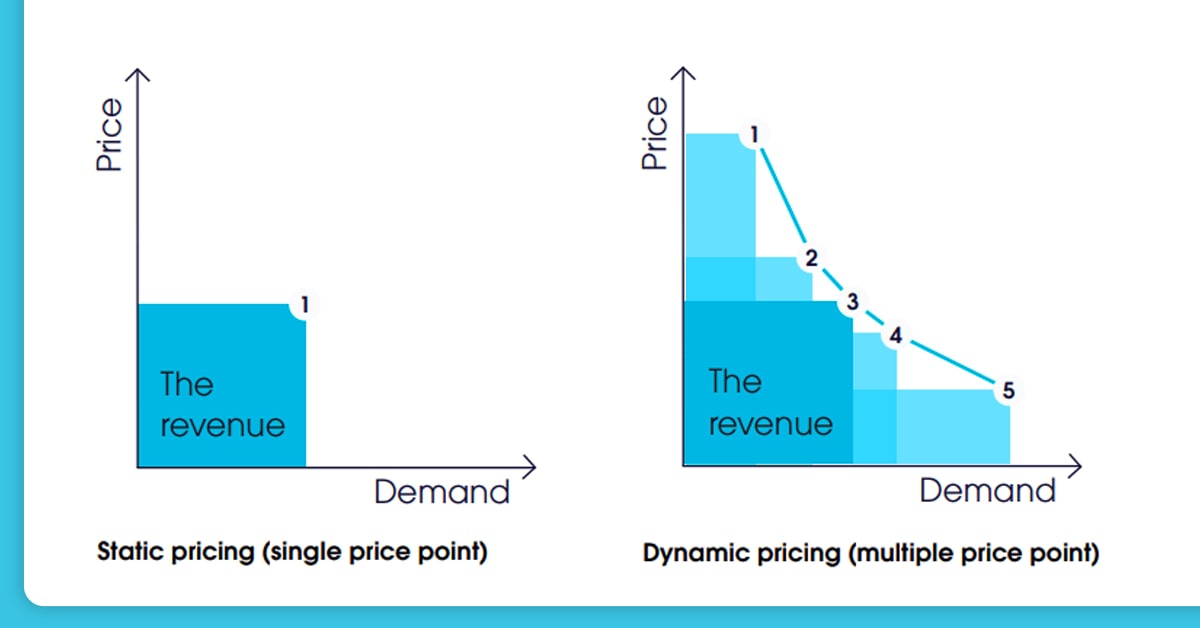
Companies can use dynamic pricing to create adjustable rates for their products or services depending on user needs. Prices are modified in response to changes in supply and demand, competition prices, and some other market factors.
Incorporating dynamic pricing into a corporate plan might be a contentious issue. If corporations take advantage of genuine pricing, they risk damaging their reputation. This will be addressed in further detail under the heading of dynamic pricing difficulties.

Types of Dynamic Pricing
Different forms of dynamic pricing are used in different sectors, depending on stock levels, consumer expectations, and other variables. The two basic forms of dynamic pricing are as follows:
Limited Supply

With small quantities, dynamic pricing means that the price change depends on the customer activity. When supplies are limited or expiring, such as flight tickets or upgrades, this form of dynamic pricing is particularly frequent in the transportation and logistics industries.
Price Matching

Matching prices includes altering the price of the product in response to price changes made by competitors. This form of pricing is most popular in the retail business and is dependent on demand fluctuations or expiration dates.
Defining Dynamic Pricing Policies

Using a dynamic price structure, you may change the price of a product or service based on demand and several other factors. Companies create various pricing points to boost income rather than having only one.
Varieties of Dynamic Pricing Policies
1. Segmented Pricing
Segmented pricing is where customers are divided into segments, and prices are determined for each group. For instance, returning clients might receive discounted merchandise or services.
2. Time-Based Rates
Time-based pricing refers to adjusting rates depending on how quickly a service is delivered. For instance, charging extra for same-day delivery.
3. Variations in Market Situations
Evolving market conditions motivate sellers to alter their pricing in response to market conditions. If sales decline, pricing may fall as well.
4. Peak Pricing or Peak Load Pricing
Peak pricing is also known as peak load pricing, refers to the act of charging extra during prime times. For example, sports clubs may charge extra for weekend memberships, while hotels may cost more during weekend stays.
5. Levels of Pricing
When corporations wish to reach the target audience, they adopt the penetration pricing model. Businesses raise their prices lower than the market average at initially, then progressively boost them.
What is the Example of Dynamic Pricing?

Airlines, sports tickets, transportation services, and e-commerce sites are some of the most prominent dynamic pricing examples.
Airlines, for example, modify ticket rates in response to demand. When prices increase, ticket prices are raised to increase income. When a large number of tickets remain unsold around the scheduled flight, ticket prices tend to fall.
Intelligent pricing is also used by e-commerce platforms to regulate supply and demand. Inventory levels, rival prices, and even customer geography are all elements that would go into their dynamic pricing approach.
What are the Advantages of Dynamic Pricing?
Dynamic pricing provides a lot of benefits, the most important of which are as follows:
1. Stock Management or Demand Supply Management

In the event of operational obstacles, dynamic pricing provides for demand management. If necessary, adjusting pricing also aids in the sale of surplus items. Data on market patterns enables businesses to anticipate peak demands and ensure that necessary product supply are available.
2. Customer Behavior Insights

Companies can learn a lot about their consumers if they have a lot of data about them. Data analysts can, for example, gather competition information and evaluate what a buyer would buy the product or services at the minimum and maximum price points. This data may then be utilized to increase sales by adjusting pricing.
3. Revenue

Having many pricing points provides multiple profits. One of the primary advantages of real-time pricing is an increase in revenue.
Dynamic Pricing Challenges
Price Discrimination

Real-time pricing creates a healthy intensity of competition in a variety of marketplaces. Real-life instances reveal, however, that some organizations may go too far end up destroying their brand’s reputation.
Increasing pricing during peak hours, like Uber, a transportation firm, does, might backfire. During instances where people needed transportation the most, such as a snowstorm in New York City, the firm raised costs. Customers were accused of being exploited by the firm.
Solution: Price discrimination should not be the result of dynamic pricing. Healthy competition may assist both businesses and their customers, but profiting under unusual circumstances, such as force majeure, might harm a brand’s reputation.
• Customer Satisfaction

Using a flexible pricing approach might be viewed as a challenging business choice. Customers may perceive it as unfair and go to a different brand.
Solution: The best solution is to be clear about real-time pricing. Customers value honesty and the ability to make their own decisions.
• Data Acquisition

Companies must continually monitor their competitors’ prices in real time to apply surge pricing. One of the most difficult aspects of variable pricing is data collecting, especially on a big scale.
Solution: The E-Commerce Scraper API is a real-time solution for capturing massive amounts of data from even the most difficult targets. This tool requires no further administration or resources.
Is Dynamic Pricing Legal?
Dynamic pricing is lawful, but there are a few limitations. According to findlaw.com, pricing discrimination based on gender, ethnicity, religion, or nationality is banned. Companies should also be honest about their use of dynamic pricing in order to avoid violating consumer rights.
According to some sources, “it is not illegal price discrimination if pricing is charged to different clients for a good faith purpose, such as a [sic] an effort by the supplier to match the competitor’s cost or a change in market conditions.”
Conclusion
Dynamic pricing solutions are gaining traction. Airlines, shops, e-commerce enterprises, and transportation services, to mention a few, use them. Direct control over pricing strategy, better stock management, and increased revenue are the key advantages of real-time pricing.
However, without the right tools, adopting price intelligence takes a lot of time and effort. Large-scale data collecting, for example, presents obstacles that can only be overcome with strong data collection technologies. Companies use dependable data-collecting technologies like E-Commerce Scraper API to tackle this problem.
For more information on Dynamic Pricing, contact X-Byte Enterprise Crawling today or ask for a free quote!
